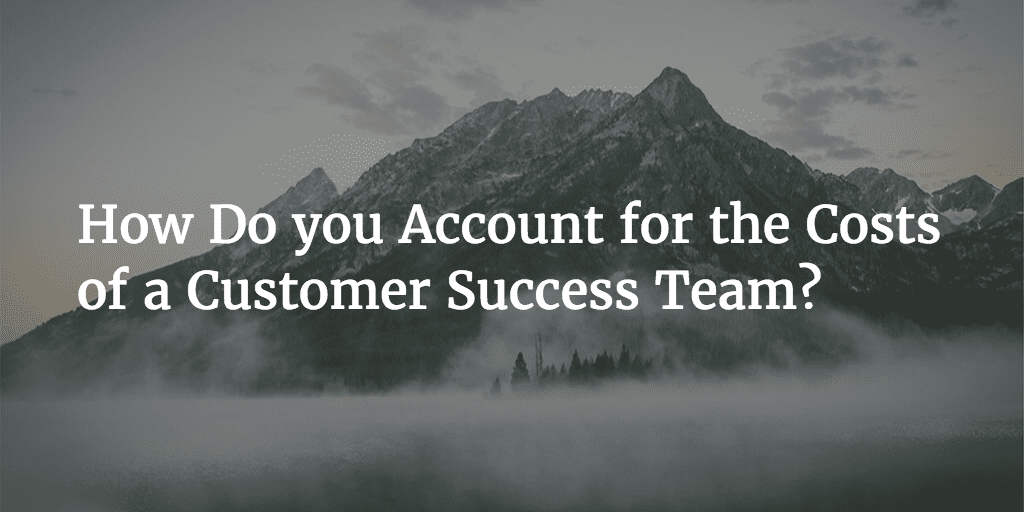We have been debating this a lot internally here at Gainsight. In short, we were trying to figure out if the cost of a Customer Success Team should be accounted for as Cost of Goods Sold or Sales and Marketing. You would think there would be a single and very straightforward answer, but the more we discussed it, the more nuanced things became.
The reason the question gets so nuanced so quickly is the role of a CSM is one of nuance itself. A CSM does a lot of things during the day and some of those things are typically accounted for as COGS (Training, Support) while others are typically accounted for as a Sales & Marketing expense (Renewal, Up-sell). Things get even more complicated as the roles & responsibilities of a CSM shift from company to company or even segment to segment within the same company.
To try to get to some kind of consensus we recently hosted a breakfast of Finance & Customer Success Executives to discuss the topic and understand how they approach it. We were lucky enough to gather a diverse group of executives representing a nice cross-section of the Customer Success Industry. As diverse as the stakeholders sitting in the room, so were my expectations for the session…
My best-case scenario:
- We have a spirited conversation about accounting for Customer Success Costs over perfect eggs and hot coffee
- We all come to consensus on the best method, ending with a group high-five
- I march off to the Financial Accounting Standards Board where I am welcomed with open arms and I make valuable US GAAP additions to the eXtensible Business Reporting Language (XBRL)
- One year later, I am on stage at Davos taking praise from our world leaders for making every Controller’s life easier and directly impacting GWP
My worst-case scenario:
- We have a combative conversation about accounting for Customer Success Costs over bad eggs and cold coffee
- We can’t come to any true consensus and I leave the room even more confused than when I started
- I fall into a deep depression, lose my job and end up living back in my parents basement
Just to let you know, I am not writing this blog post from Switzerland and thankfully, I’m not writing it from my parent’s basement either. First and foremost, the eggs were excellent. As for accounting for the costs of Customer Success, Finance Departments are doing it a lot of different ways and we are still very far from aligning as an industry around standard accounting practices for Customer Success. With that said, I was able to capture some interesting results that will be explored below

- The above matrix will serve as the framework to understand how Customer Success is being accounted for across the industry
- The X Axis shows the two approaches to allocating Customer Success Costs
- By Responsibility – allocating based on the different tasks that a Customer Success Manager drives everyday (training, usage, renewals, etc.)
- By Department – allocating based on where Customer Success Team sits within the larger organization
- The Y Axis are the two most common accounting cost types of Customer Success
- Sales & Marketing Expense – the costs associated with selling to a prospect or customer
- Cost of Goods Sold (COGS) – the costs associated with maintaining, customizing, implementing or training a customer
- The circles represent each company we spoke to at the breakfast or our subsequent survey follow-up

4 of the 7 companies are aligning their costs by department with an even split between COGS and Sales & Marketing

The companies in green, are both very large publicly traded technology companies that have completed, or are in the midst of transitioning their Renewal Teams to a more Customer Success oriented model. Because these Customer Success Teams (previously Renewal) sit within the Sales Department, all of their costs are associated with Sales & Marketing. The key take-away from the Finance Executives at both these companies: if the CSM owns or merely supports any piece of the commercial discussion (Renewal, Up-Sell, X-sell), they are part of the Sales Department and their costs are accounted for as Sales Marketing. With that said, these companies have very, very large Sales Organizations and the overall impact of the CSM costs to the larger Sales Department is minimal. To quote one CFO, “if the CSM costs ever become material to the larger Sales Organization, we would break them out separately.”

The companies in yellow, are following the same methodology to the companies circled in green, but their starting point is different. These companies have transitioned a portion of their Support Organization or built a net new Customer Success Team within their larger Support and Training Organizations. Because the Customer Success Teams sit within the Training and Support Organization, the Customer Success costs are considered COGS. Furthermore, the core mandate of both Customer Success Teams is to drive retention by making sure the solutions are achieving the customer’s needs. Another team, within the Sales Department, drives the renewal process and any up-sell or x-sell opportunities identified by Customer Success is quickly handed over to Sales. The Customer Success Teams are removed from any commercial discussion, therefore their costs are considered COGS.

3 of the 7 companies are aligning their costs by the responsibility of the resources that sit within the Customer Success Team. Both are mid-size technology companies that have clear delineation of responsibilities and resource types that make up the team.

The roles and responsibilities of the Customer Success Team of the company in blue is much more similar to your typical Customer Success Team at a mid-sized technology company. The responsibilities span the entire spectrum, both commercial and non-commercial and they shift dependent of the segment a Customer Success Manager might own. For this reason, which is essentially lack of clarity of where the Customer Success Managers are spending their time, the company decided to split the costs of the team right down the middle with a 50/50 allocation to both COGS and Sales and Marketing.

Both companies in purple have mapped the responsibilities of their Customer Success Teams, dedicated specialized resources to those responsibilities, then mapped those resources to either a Sales & Marketing or COGS expense. Like all other companies we reviewed today, the clear cost delineation point between Sales & Marketing & COGS for Customer Success seems to be ownership of the commercial transaction.

Up until now I have been able to fit everything into a neat and tidy matrix. Who doesn’t love a good matrix? Where the matrix turns into a Dali painting is when we start talking about one of the key, if not the key, responsibilities of a Customer Success Manager, driving product usage. Most of the stakeholders at the breakfast tended to put the responsibility of driving product usage as a non-commercial activity and thus squarely in the COGS category. I disagree with this assertion and let me lay out a few scenarios against the COGS categorization of driving product usage.
- Scenario 1: A consumption-based pricing model. If a customer’s increase in product usage is directly linked to an increase of revenue, the Customer Success Manager is driving revenue on behalf of the company and engaging in a sales activity.
- Scenario 2: Driving a cross-departmental product demonstration. Often the Customer Success Manager is asked to demo the product to another department of their customer. The goal of this demo might be to show how a cross-functional process is now optimized, or they might be playing the role of Solution Consultant for an Account Manager that is driving an expansion sale. Regardless, of the goal of the demonstration, the CSM is demonstrating the product to potential buyers and engaging in a sales activity.
- Scenario 3: The Quarterly Business Review. For large deployments of any solution, the QBR will have leadership representation from across the company. This is a time to review the state of the business, ensure a customer’s goals are being (or going to be) met and continue to identify use cases to drive value. If the CSM is running the QBR right, they are engaging in a sales activity.
In closing, strong product usage is the best proxy for understanding the value the customer is getting from the solution as well as any near-term sales expansion opportunities. This is why some of your best salespeople (and costs) are not salespeople at all, but your best Customer Success Managers.
- Owning the commercial discussion (renewal, up-sell, x-sell) is the key delineation point between expense type, it is then up to the organization to decide if they map all or some those expenses to an entire department or if drill down to responsibility and allocate from there.
- The companies that have transformed a legacy department into a Customer Success department have maintained the accounting practices that were in place before the transformation occurred.
- Though difficult for very large companies, mapping the responsibilities of the Customer Success Team and allocating the expense accordingly will provide the best visibility and control of the business.
- As the Customer Success function matures and begins to permeate across other industries, the need to map responsibilities to the proper expense type will continue to grow.
- How companies across the industry are accounting for the cost of driving product usage is inconsistent. With that said, driving product usage is a major driver of revenue growth regardless of how the costs are eventually classified.
Thanks for reading and feel free to reach out if you any questions regarding the post.

